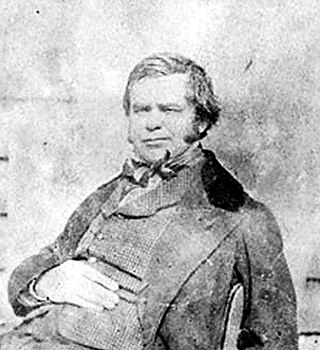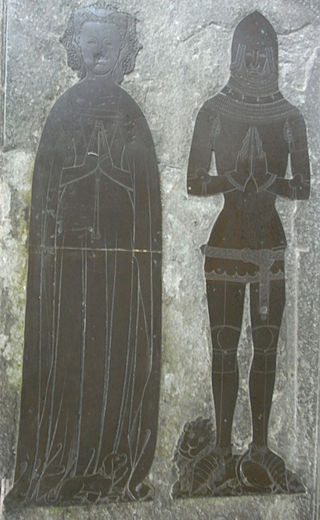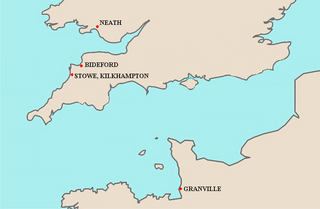Related Research Articles

Bridgend is a town in the Bridgend County Borough of Wales, 20 miles (32 km) west of Cardiff and 20 miles (32 km) east of Swansea. The town is named after the medieval bridge over the River Ogmore. The River Ewenny also flows through the town. The population was 49,597 in 2021. Bridgend is within the Cardiff Capital Region which in 2019 had a population of approximately 1.54 million.

Olveston is a small village and larger parish in South Gloucestershire, England. The parish comprises the villages of Olveston and Tockington, and the hamlets of Old Down, Ingst and Awkley. The civil parish population at the 2011 census was 2,033. Alveston became a separate church parish in 1846. The district has been inhabited since the Stone Age, and the salt marshes that made up almost half of the parish, were progressively drained in Roman and Saxon times. A sea wall was constructed at the same time to prevent flooding from the nearby estuary of the River Severn.

Hugh le Despenser, 1st Baron le Despenser, Lord of Glamorgan, was an English peer. Imprisoned as a consequence of his support for deposed king Edward II, he would return to royal favour under Edward III, being made Baron le Despenser in 1338. His title became extinct at his death without issue.

Colonel George Thomas Clark was a British surgeon and engineer. He was particularly associated with the management of the Dowlais Iron Company. He was also an antiquary and historian of Glamorgan.
Llywelyn Bren, or Llywelyn ap Gruffudd ap Rhys / Llywelyn ap Rhys or in English: Llywelyn of the Woods. He was a nobleman who led a 1316 revolt in Wales in the reign of King Edward II of England. It marked the last serious challenge to English rule in Wales until the attempts of Owain Lawgoch to invade with French support in the 1370s. Hugh Despenser the Younger's unlawful execution of Llywelyn Bren helped to lead to the eventual overthrow of both Edward II and Hugh.

Coity Castle in Glamorgan, Wales, is a Norman castle built by Sir Payn "the Demon" de Turberville, one of the legendary Twelve Knights of Glamorgan supposed to have conquered Glamorgan under the leadership of Robert FitzHamon, Lord of Gloucester. Now in ruins, it stands in the community of Coity Higher near the town of Bridgend, in the County Borough of Bridgend. Very close to the castle is the battlemented parish Church of St Mary the Virgin, which dates from the 14th century.
Richard de Beauchamp, Earl of Worcester, KB was an English peer.
This page is a list of High Sheriffs of Glamorgan. Sheriffs of Glamorgan served under and were answerable to the independent Lords of Glamorgan until that lordship was merged into the crown. This is in contrast to sheriffs of the English shires who were from the earliest times officers of the crown. Sheriffs in the modern sense, appointed and answerable to the crown, were instituted in the county of Glamorgan in 1541.

Thomas de Berkeley, 5th Baron Berkeley, The Magnificent, of Berkeley Castle and of Wotton-under-Edge in Gloucestershire, was an English peer and an admiral. His epithet, and that of each previous and subsequent head of his family, was coined by John Smyth of Nibley (d.1641), steward of the Berkeley estates, the biographer of the family and author of "Lives of the Berkeleys".
Mabel FitzRobert, Countess of Gloucester was an Anglo-Norman noblewoman, and a wealthy heiress who brought the lordship of Gloucester, among other prestigious honours to her husband, Robert, 1st Earl of Gloucester upon their marriage. He was the illegitimate son of King Henry I of England.
The Twelve Knights of Glamorgan were a "legendary" group of mercenaries who followed Robert Fitzhamon (d.1107), the Norman conqueror of Glamorgan. Although Fitzhamon was an actual historical figure, 16th-century historians, in particular Sir Edward Stradling, built upon the legend of a group of knights who ruled over the county in his stead. The fact that many of the knights existed during the period gave the legend credence.
Sir Gilbert Denys of Siston, Gloucestershire, was a soldier, and later an administrator. He was knighted by January 1385, and was twice knight of the shire for Gloucestershire constituency, in 1390 and 1395 and served as Sheriff of Gloucestershire 1393-4. He founded the family which provided more Sheriffs of Gloucestershire than any other.

Sir Maurice Denys (1516–1563) of Siston Court, near Bristol, Gloucestershire, and of St John's Street, Clerkenwell, Middlesex, was an English lawyer and property speculator during the Dissolution of the Monasteries, at which time he served as a "powerful figure at the Court of Augmentations". He served as a Member of Parliament for Malmesbury in Wiltshire and as Treasurer of Calais. He was the builder of Siston Court in Gloucestershire, which survives largely unaltered since his time. His excessive speculation and borrowing caused the ruination of the Siston branch of the Denys family.

Sir John Seymour of Wulfhall in Savernake Forest, Wiltshire, feudal baron of Hatch Beauchamp in Somerset, England, was a Member of Parliament.

Maurice Denys, Esquire, of Siston, Gloucestershire, was twice Sheriff of Gloucestershire in 1460 and 1461. The Denys family were stated by Sir Robert Atkyns, the 18th-century historian of Gloucestershire, to have provided more sheriffs for that county than any other family.

Henry Dennis was High Sheriff of Gloucestershire in 1629. He was lord of the manor of Pucklechurch, Gloucestershire. The Dennis family produced more Sheriffs of Gloucestershire than any other family. Like many members of the Gloucestershire gentry he refused to take a knighthood at the coronation of King Charles I in 1625, for which he paid a composition of £25.
The surname Denys was borne by at least three prominent mediaeval families seated in Gloucestershire, Somerset and Devon in southwest England between 1166 and 1641. It is not known if any relationship existed between these families. The surname Denys is just one of many variant spellings of the name: Denise, Le Deneis, Le Danies, le Deneys ,and most recently Dennis, are some of the others.
Manor of Siston is the ancient manor in Siston in South Gloucestershire, England.
The Denys family of Siston, also spelled Dennis, originally came from Glamorgan in Wales and in the late 14th century acquired by marriage the manor of Siston, Gloucester and shortly thereafter the adjoining manor of Dyrham. Maurice Denys re-built Siston Court in the 16th century.

Sir Richard de Grenville was one of the Twelve Knights of Glamorgan who served under Robert FitzHamon, in the conquest of Glamorgan in Wales. He obtained from FitzHamon the lordship of Neath in which he built Neath Castle and in 1129 founded Neath Abbey. He is by tradition the founder and ancestor of the prominent Westcountry Grenville family of Stowe in the parish of Kilkhampton in Cornwall and of Bideford in Devon, the later head of which family was John Granville, 1st Earl of Bath (1628–1701). The surname of his supposed descendants the Westcountry Grenville family was spelled by tradition "Grenville" until 1661 when it was altered to "Granville".